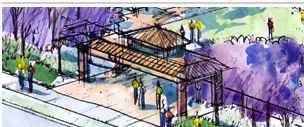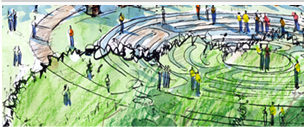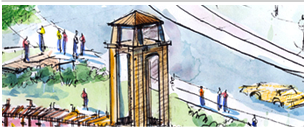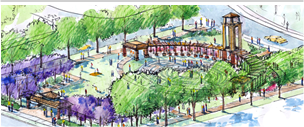This month we’ve briefly reviewed the shifts in large-scale urban infrastructure design. Effective technological innovations in transportation, communications, energy, and environmental services (water, wastewater, garbage disposal) in the 19th and early 20th century enabled economic growth, and contributed to the physical transformation of city planning and development.
Today, cities across the globe are embracing ‘sustainable’ or ‘green’ infrastructure initiatives to re-design failing, ‘grey’ engineered systems. Many are embracing innovations that sidestep an old structure entirely. For example, Vietnam, a country of coastal views, aims to join global “Green Cities” such as Stockholm and Singapore, by implementing large scale urban changes in three cities in the northern and central provinces. To become a Green City, standards of green space, constructions, transport and industry are met.
Green infrastructure can serve multiple functions, including public health.

As an urban dweller, green infrastructure change is experienced directly on the ground in the form of parks, natural areas, and newer types of ‘metro nature’. For example, engineering strategies at a large scale – schools, libraries, and apartment buildings – contain community features such as green roofs and living walls. Grey infrastructure systems are retrofitted with ecological elements such as roadside plantings that become wetlands and support wildlife. Historic spaces can provide food and shelter for pollinators, community gardens contribute to reduced pollution, and water retention sites provide opportunities for learning. The consideration of public health in green infrastructure design harkens back to 19th century efforts to provide potable water for city residents.
Intimate, mentally restorative spaces can be tucked into large-scale infrastructure.
A holistic, optimistic approach to health supports productive individuals, and livable communities where people can thrive. Health is not simply an absence of disease or infirmity, but is a state of complete physical, mental and social well-being. Wholesome living environments integrate the opportunities of built, social, natural, and (increasingly) online components to help people be at their best. One important aspect of health – mental function and wellness – is not only the outcome of personal and lifestyle situations, but is highly dependent on the natural and built environments that surround a person.
The TKF Foundation has funded the design and construction of more than 130 Open Spaces, Sacred Places. In a rather spontaneous way, a pattern of design elements has emerged and these are remarkably consistent with historic designs of outdoor sanctuaries, contemplative spaces and healing gardens. The key elements are portal, path, destination and surround.




These spaces serve a ‘civic sacred’ function, and current research is underway to evaluate measurable health benefits from spending time in these spaces.
Civic sacred refers to the everyday encounters with nature in cities that have the potential to promote inspiration, deeper thinking, mindfulness, and social and cultural connections, and may be transformational.
These four elements of Open Spaces, Sacred Places are not meant to be design formula, but describe the spatial characteristics that have been found to support moments of contemplation and respite. There can be a sense of variety within unity, that is, there are infinite sets of possibilities for design expression of sacred spaces while still generally incorporating the design elements. A participatory process of design may introduce meaningful details that recall unique characteristics or remembrances of a community, or the symbols and important messages of different cultural groups. There may also be a system or linked set of civic sacred spaces within a community, all connected in concept, but each having somewhat different features, characters, or a user group.
